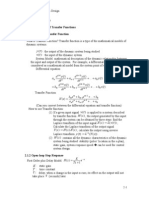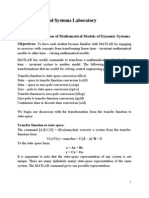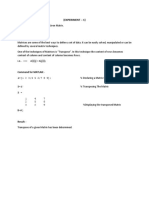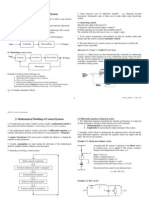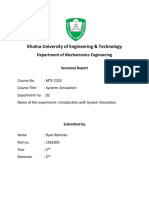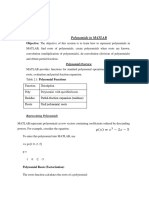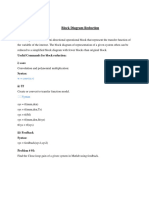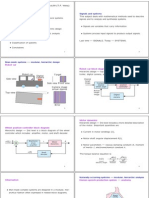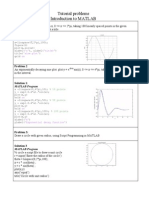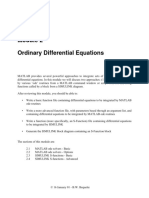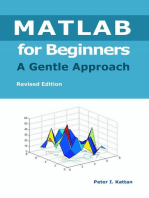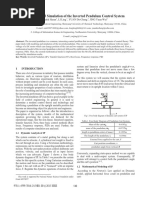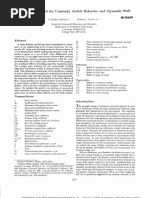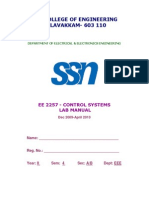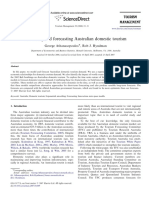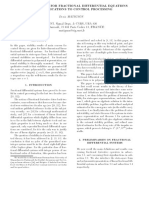Matlab Training Session Iv Simulating Dynamic Systems: Sampling The Solution Equation
Matlab Training Session Iv Simulating Dynamic Systems: Sampling The Solution Equation
Uploaded by
Ali AhmadCopyright:
Available Formats
Matlab Training Session Iv Simulating Dynamic Systems: Sampling The Solution Equation
Matlab Training Session Iv Simulating Dynamic Systems: Sampling The Solution Equation
Uploaded by
Ali AhmadOriginal Description:
Original Title
Copyright
Available Formats
Share this document
Did you find this document useful?
Is this content inappropriate?
Copyright:
Available Formats
Matlab Training Session Iv Simulating Dynamic Systems: Sampling The Solution Equation
Matlab Training Session Iv Simulating Dynamic Systems: Sampling The Solution Equation
Uploaded by
Ali AhmadCopyright:
Available Formats
Simulating Dynamic Systems
MATLAB TRAINING SESSION IV SIMULATING DYNAMIC SYSTEMS
MATLAB provides a variety of techniques for solving dynamics problems numerically. On-line help for each of the commands shown below is available by typing help command_name or doc command_name at the MATLAB prompt.
Sampling the Solution Equation:
Suppose you already have the solution to a dynamics problem and you want to obtain a plot of the response. The task would reduce to implementing the equation in MATLAB and sampling the function over some domain of interest. For a high delity reproduction of the function, the function must be sampled with a spacial or time increment that captures many samples for each frequency that comprises the Fourier series for the function. In simpler terms, we can tell if we have used a small enough increment if the resulting plot appears smooth. The example shows how the same function can look jagged or smooth in the plot depending on the sampling increment.
1 of 9
Simulating Dynamic Systems
Suppose we nd:
y(t ) = 8 5e
2 t
( sin ( 2 t ) + 0.5 cos ( 2 t ) )
Linear Systems:
There are three general purpose methods for solving dynamics problems; transfer function method, state space integration method, and the MATLAB function lsim. Transfer Function Method: The transfer function method uses partial fraction expansion of the transfer function multiplied by the Laplace transform of the forcing function to obtain the solution. The solution of the differential equation is expressed in terms of a linear combonation of complex exponentials that are determined by the poles and the corresponding residues in the partial fraction expansion. Thus the form of the solution is: y(t ) =
r ( i ) exp ( p ( i ) t )
i=1
Suppose we have Then we can write
y + 2 y + 5 y = 5u(t ) + u ( t )
and
u ( t ) = input
2 of 9
Simulating Dynamic Systems
s Y ( s ) sy ( 0 ) y ( 0 ) + 2 sY ( s ) 2 y ( 0 ) + 5 Y ( s ) = 5 U ( s ) + sU ( s ) + u ( 0 ) Let y(0) = 0 y ( 0 ) = 0 u(0) = 0 s+5 -U (s) Then Y ( s ) = ------------------------2 s + 2s + 5 Let the input u(t) be the step function and to solve for y(t) do With 1 U ( s ) = -s then s+5 Y ( s ) = --------------------------------2 s(s + 2s + 5)
Let u(t) be sin(2t) and to solve for y(t) do
2 U ( s ) = ------------2 s +4
3 of 9
Simulating Dynamic Systems
Integration Method: The integration method utilizes the state space representation of the system and the MATLAB ode23 or the ode45 integrator. One advantage of this method is that it is much easier to incorporate the initial conditions in the solution without having to nd the new transfer function. Lets look at the last example given above. x ( t ) = 0 1 x ( t ) + 0 u ( t ) x = Ax + Bu 5 2 1 The state space representation is y = 5 1 x(t ) To implement the model create the M-le eqn1.m as shown y = Cx + Du
4 of 9
Simulating Dynamic Systems
Then at the MATLAB prompt, enter:
Special Purpose MATLAB Commands: The MATLAB control systems toolbox provides several built in functions for solving for the solution to linear dynamic equations. All functions except either the transfer function or the state space representations. When the functions are invoked with left hand arguments, the variable are lled and a no plot is made. Each function has a variable number of possible valid argument congurations. Most function support both transfer function (num/den) and state space (A,B,C,D) forms. More information about each function can be found by typing help function_name. A list is provided below.
initial(A,B,C,D,x0) impulse(num,den,t)
impulse(A,B,C,D,IU,t) step(num,den,t) step(A,B,C,D,IU,t) lsim(num,den,U,t) lsim(A,B,C,D,U,t,x0)
Initial condition response of cont-time LTI systems Impulse response of continuous time LTI systems IU = input channel number; t = sample time vector Step response of continuous time LTI systems Simulation of c-time LTI systems to arbitrary inputs U = input time history (# of columns = # of inputs)
5 of 9
Simulating Dynamic Systems
For example lets work with the series resonant circuit: di 1 - i d = V s Ri + L + --dt C
0 t
THEN
2
LC
di di dV + RC + i = C dt dt dt I (s) Cs ---------- = ------------------------------------------2 V (s) ( LCs + RCs + 1 ) C
Vs
( RCs + LCs + 1 ) I ( s ) = CsV ( s )
OR
x1 = i
x2 = x 1
x 1 x 2
0 1 x 1 = + 0 u 1 R ------- -- x 1 LC L 2
1 x1 y = 0 -L x2
With Matlab:
There is a corresponding function for discrete time dynamics for the functions mentioned above . The function would start with a d like dstep for example. Suppose we nd the z-transform to be Then 0.4673 z 0.3393 G ( z ) = ---------------------------------------------------2 z 1.5327 z + 0.6607
6 of 9
Simulating Dynamic Systems
Nonlinear Systems: Nonlinear dynamics are solved by the integration method. The system equations are expressed in state form described in a M-le function and the ode integrators are used to solve for the state trajectories. 1 - [ x1 + x2 g ( x2 ) ] x 1 = -----------C 1 R1 Consider the Wien-Bridge Oscillator: 1 1 - [ x 1 + x 2 g ( x 2 ) ] ------------x x 2 = -----------C 2 R1 C 2 R2 2 g ( v ) = 3.234 v 2.195 v + 0.666 v Create the M-le wien.m as shown (Let R1 = R2 = C1 = C2 = 1.0)
3 5
Then with MATLAB
7 of 9
Simulating Dynamic Systems
Consider the Cart and Pendulum Problem 2 sin = 0 (M + m)x + ml cos ml sin + mgl sin = 0 ml + mlx cos mlx Use a change of variables to y then we can write y1 x(t ) y x ( t ) = 2 (t ) y3 (t) y4 Write the M-le cart.m 1 0 0 0 0 ( M + m ) 0 ml cos y 3 0 0 1 0 ml
2 2
y 1 y 2 y 3 y 4 =
y2 mly 4 sin y 3 y4 ml ( y 2 y 4 g ) sin y 3
2
0 ml cos y 3 0
Then with MATLAB
8 of 9
Simulating Dynamic Systems
9 of 9
You might also like
- HW2Document3 pagesHW2Mohammad JbaratNo ratings yet
- Lab 4: Linear Time-Invariant Systems and Representation: ObjectivesDocument6 pagesLab 4: Linear Time-Invariant Systems and Representation: ObjectivesFahad AneebNo ratings yet
- Identification: 2.1 Identification of Transfer Functions 2.1.1 Review of Transfer FunctionDocument29 pagesIdentification: 2.1 Identification of Transfer Functions 2.1.1 Review of Transfer FunctionSucheful LyNo ratings yet
- FEEDLAB 02 - System ModelsDocument8 pagesFEEDLAB 02 - System ModelsAnonymous DHJ8C3oNo ratings yet
- Lab 06 PDFDocument7 pagesLab 06 PDFAbdul Rehman AfzalNo ratings yet
- Exp 6 FEEDLABDocument9 pagesExp 6 FEEDLABadrianmortiz28No ratings yet
- Lcs Exp4 SolvedDocument16 pagesLcs Exp4 SolvedLaiba YousafNo ratings yet
- ENGM541 Lab5 Runge Kutta SimulinkstatespaceDocument5 pagesENGM541 Lab5 Runge Kutta SimulinkstatespaceAbiodun GbengaNo ratings yet
- Lab 2-CS-Lab-2020Document12 pagesLab 2-CS-Lab-2020Lovely JuttNo ratings yet
- Linear Control System Lab: Familiarization With Transfer Function and Time ResponseDocument14 pagesLinear Control System Lab: Familiarization With Transfer Function and Time ResponseMuhammad Saad AbdullahNo ratings yet
- MATLAB ProblemsDocument4 pagesMATLAB ProblemsPriyanka TiwariNo ratings yet
- Matlab Basics Tutorial: Electrical and Electronic Engineering & Electrical and Communication Engineering StudentsDocument23 pagesMatlab Basics Tutorial: Electrical and Electronic Engineering & Electrical and Communication Engineering StudentssushantnirwanNo ratings yet
- Sos 2Document16 pagesSos 2youssef_dablizNo ratings yet
- ELG4152L305Document33 pagesELG4152L305Rahul GalaNo ratings yet
- ELE 421 Control Systems Laboratory# 1Document6 pagesELE 421 Control Systems Laboratory# 1Avi SinghNo ratings yet
- Lab 3-CS-LabDocument12 pagesLab 3-CS-Labهاشمی دانشNo ratings yet
- System Analysis Using Laplace Transform: 1. PolynomialsDocument11 pagesSystem Analysis Using Laplace Transform: 1. PolynomialsnekuNo ratings yet
- Assignment 2 Matlab RegProbsDocument4 pagesAssignment 2 Matlab RegProbsMohammed BanjariNo ratings yet
- Aim: - To Find Transpose of A Given Matrix. Apparatus: - MATLAB Kit. TheoryDocument10 pagesAim: - To Find Transpose of A Given Matrix. Apparatus: - MATLAB Kit. TheoryGaurav MishraNo ratings yet
- HET312 NotesDocument41 pagesHET312 NotesTing SamuelNo ratings yet
- Lab-2-MTE-2210 RyanDocument18 pagesLab-2-MTE-2210 RyanFaria Sultana MimiNo ratings yet
- lab 02 updatedDocument6 pageslab 02 updatedammaradil817No ratings yet
- Expt 2 Transfer Function 1Document6 pagesExpt 2 Transfer Function 1JHUSTINE CAÑETENo ratings yet
- Lab-2-Course Matlab Manual For LCSDocument12 pagesLab-2-Course Matlab Manual For LCSAshno KhanNo ratings yet
- State Variable ModelsDocument13 pagesState Variable Modelsali alaaNo ratings yet
- LTIDocument16 pagesLTIAhmed AlhadarNo ratings yet
- Lab No. 3-Block Diagram ReductionDocument12 pagesLab No. 3-Block Diagram ReductionAshno KhanNo ratings yet
- Expt 2 Transfer FunctionDocument4 pagesExpt 2 Transfer Functions2121698No ratings yet
- A Mathematical Approach of Fractional-Order Systems: Costandin Marius-SimionDocument4 pagesA Mathematical Approach of Fractional-Order Systems: Costandin Marius-SimionMOKANSNo ratings yet
- ps3 (1) From MAE 4780Document5 pagesps3 (1) From MAE 4780fooz10No ratings yet
- Mfa Merit Exercises 5 Simulink 5174 2Document8 pagesMfa Merit Exercises 5 Simulink 5174 2JamesNo ratings yet
- MatlabhintsDocument5 pagesMatlabhintsVeljkoNo ratings yet
- Experiment No.1: Introduction To Lti Representation and Transfer Function ModelDocument7 pagesExperiment No.1: Introduction To Lti Representation and Transfer Function ModelIra CervoNo ratings yet
- Signals and Systems: Lecture #2: Introduction To SystemsDocument8 pagesSignals and Systems: Lecture #2: Introduction To Systemsking_hhhNo ratings yet
- Linear Control Systems LabDocument87 pagesLinear Control Systems Labaliabeed323No ratings yet
- Activity No. 3 The Transfer Function and System ResponseDocument3 pagesActivity No. 3 The Transfer Function and System ResponseChester Kyles ColitaNo ratings yet
- Lab2 Control SystemDocument43 pagesLab2 Control Systemعبدالملك جمالNo ratings yet
- Control System Lab Exercise PDFDocument59 pagesControl System Lab Exercise PDFilijakljNo ratings yet
- Matlab, Simulink - Control Systems Simulation Using Matlab and SimulinkDocument10 pagesMatlab, Simulink - Control Systems Simulation Using Matlab and SimulinkTarkes DoraNo ratings yet
- Mathematical Modelling& Various Control System Models & Responses Using MatlabDocument45 pagesMathematical Modelling& Various Control System Models & Responses Using MatlabJagabandhu KarNo ratings yet
- Control System 2014 Midterm Exam. 1 (2 Pages, 38 Points in Total)Document7 pagesControl System 2014 Midterm Exam. 1 (2 Pages, 38 Points in Total)horace2005No ratings yet
- Chapter 1Document8 pagesChapter 1hitesh89No ratings yet
- Chapter 8 State Space AnalysisDocument22 pagesChapter 8 State Space AnalysisAli AhmadNo ratings yet
- 3723 Lecture 18Document41 pages3723 Lecture 18Reddy BabuNo ratings yet
- Ex Signal and SystemDocument25 pagesEx Signal and SystemNguyen Van HaiNo ratings yet
- Lab 3Document4 pagesLab 3Trang PhamNo ratings yet
- Z TransformDocument22 pagesZ Transformvignanaraj100% (1)
- Matlab LectureDocument6 pagesMatlab Lecturekafle_yrsNo ratings yet
- Lect Note 1 IntroDocument28 pagesLect Note 1 IntroJie RongNo ratings yet
- Control System IDocument12 pagesControl System IKhawar RiazNo ratings yet
- 6 MatLab Tutorial ProblemsDocument27 pages6 MatLab Tutorial Problemsabhijeet834uNo ratings yet
- Ordinary Differential EquationsDocument12 pagesOrdinary Differential EquationsKapilSahuNo ratings yet
- Student Solutions Manual to Accompany Economic Dynamics in Discrete Time, second editionFrom EverandStudent Solutions Manual to Accompany Economic Dynamics in Discrete Time, second editionRating: 4.5 out of 5 stars4.5/5 (2)
- A Brief Introduction to MATLAB: Taken From the Book "MATLAB for Beginners: A Gentle Approach"From EverandA Brief Introduction to MATLAB: Taken From the Book "MATLAB for Beginners: A Gentle Approach"Rating: 2.5 out of 5 stars2.5/5 (2)
- Nonlinear Control Feedback Linearization Sliding Mode ControlFrom EverandNonlinear Control Feedback Linearization Sliding Mode ControlNo ratings yet
- Graphs with MATLAB (Taken from "MATLAB for Beginners: A Gentle Approach")From EverandGraphs with MATLAB (Taken from "MATLAB for Beginners: A Gentle Approach")Rating: 4 out of 5 stars4/5 (2)
- MATLAB for Beginners: A Gentle Approach - Revised EditionFrom EverandMATLAB for Beginners: A Gentle Approach - Revised EditionRating: 3.5 out of 5 stars3.5/5 (11)
- Matlab Training Session Iii Numerical Methods: Solutions To Systems of Linear EquationsDocument14 pagesMatlab Training Session Iii Numerical Methods: Solutions To Systems of Linear EquationsAli AhmadNo ratings yet
- Electrical Theory: Howard W Penrose, PH.D., CMRP InstructorDocument79 pagesElectrical Theory: Howard W Penrose, PH.D., CMRP InstructorSandun LakminaNo ratings yet
- The Purpose of Business Activity: LECTURE # 01 & 02Document9 pagesThe Purpose of Business Activity: LECTURE # 01 & 02Ali AhmadNo ratings yet
- The Purpose of Business Activity: LECTURE # 01 & 02Document9 pagesThe Purpose of Business Activity: LECTURE # 01 & 02Ali AhmadNo ratings yet
- Lecture 2 - 30-01-08Document17 pagesLecture 2 - 30-01-08Ali AhmadNo ratings yet
- Lectrue # 12 and 13 - 30-04-08Document26 pagesLectrue # 12 and 13 - 30-04-08Ali AhmadNo ratings yet
- Matlab Training - SIMULINKDocument8 pagesMatlab Training - SIMULINKAtta RehmanNo ratings yet
- Matlab Training Session Ii Data Presentation: 2-D PlotsDocument8 pagesMatlab Training Session Ii Data Presentation: 2-D PlotsAli AhmadNo ratings yet
- Matlab Training Session Vii Basic Signal Processing: Frequency Domain AnalysisDocument8 pagesMatlab Training Session Vii Basic Signal Processing: Frequency Domain AnalysisAli AhmadNo ratings yet
- Introduction To VHDL: AIR University AU, E-9, IslamabadDocument29 pagesIntroduction To VHDL: AIR University AU, E-9, IslamabadAli AhmadNo ratings yet
- Printing The Model:: SimulinkDocument8 pagesPrinting The Model:: SimulinkAli AhmadNo ratings yet
- Acknowledgement - 2Document11 pagesAcknowledgement - 2Ali AhmadNo ratings yet
- System On Chips Soc'S & Multiprocessor System On Chips MpsocsDocument42 pagesSystem On Chips Soc'S & Multiprocessor System On Chips MpsocsAli AhmadNo ratings yet
- Introduction To: Artificial IntelligenceDocument31 pagesIntroduction To: Artificial IntelligenceAli AhmadNo ratings yet
- Air University Fall 2005 Faculty of Engineering Department of Electronics Engineering Course InformationDocument2 pagesAir University Fall 2005 Faculty of Engineering Department of Electronics Engineering Course InformationAli AhmadNo ratings yet
- Operators: Introduction To ASIC DesignDocument6 pagesOperators: Introduction To ASIC DesignAli AhmadNo ratings yet
- 2-Level Logic ( 0', 1') .: Introduction To ASIC DesignDocument8 pages2-Level Logic ( 0', 1') .: Introduction To ASIC DesignAli AhmadNo ratings yet
- Example 5.1: Multiplexer #1 Using OperatorsDocument10 pagesExample 5.1: Multiplexer #1 Using OperatorsAli AhmadNo ratings yet
- Second SessionalCourseOutlineDocument1 pageSecond SessionalCourseOutlineAli AhmadNo ratings yet
- Chapter 1: Introduction To AsicsDocument15 pagesChapter 1: Introduction To AsicsAli AhmadNo ratings yet
- How Chips Are DesignedDocument46 pagesHow Chips Are DesignedAli AhmadNo ratings yet
- Sequential Code in VHDLDocument42 pagesSequential Code in VHDLAli Ahmad0% (1)
- Introduction To Symbian Os: AIR University AU, PAF Complex, E-9, IslamabadDocument64 pagesIntroduction To Symbian Os: AIR University AU, PAF Complex, E-9, IslamabadAli AhmadNo ratings yet
- Introduction To ASIC Design: Lab Report InstructionsDocument1 pageIntroduction To ASIC Design: Lab Report InstructionsAli AhmadNo ratings yet
- Introduction To ASIC Design: Lab Report StandardsDocument1 pageIntroduction To ASIC Design: Lab Report StandardsAli AhmadNo ratings yet
- State Machine Block DiagarmDocument6 pagesState Machine Block DiagarmAli AhmadNo ratings yet
- Assignment#5Document1 pageAssignment#5Ali AhmadNo ratings yet
- Assignment 1Document1 pageAssignment 1Ali AhmadNo ratings yet
- Assignment # 3: The EndDocument1 pageAssignment # 3: The EndAli AhmadNo ratings yet
- Assignment#4Document1 pageAssignment#4Ali AhmadNo ratings yet
- Tanterv MSC K Angol 2019 12 03 PDFDocument66 pagesTanterv MSC K Angol 2019 12 03 PDFNakachew AssefaNo ratings yet
- Modeling and Simulation of The Inverted Pendulum Control SystemDocument5 pagesModeling and Simulation of The Inverted Pendulum Control SystemKanavNo ratings yet
- Skvoretz & Fararo (2011) - Mathematical SociologyDocument14 pagesSkvoretz & Fararo (2011) - Mathematical SociologyRB.ARGNo ratings yet
- State SpaceDocument4 pagesState SpaceHai NguyenNo ratings yet
- Modelling and Control of A Hot Rolling MillDocument7 pagesModelling and Control of A Hot Rolling MillHakanNo ratings yet
- From Classical To State-Feedback-Based Controllers: Lecture NotesDocument10 pagesFrom Classical To State-Feedback-Based Controllers: Lecture Notesomarportillo123456No ratings yet
- 10 - State Space MethodsDocument20 pages10 - State Space MethodsSalim SalehNo ratings yet
- Linear and Nonlinear System Identification Using LabVIEW and MATLDocument69 pagesLinear and Nonlinear System Identification Using LabVIEW and MATLإبراهام لنكولنNo ratings yet
- State-Space Models and The Discrete-Time Realization AlgorithmDocument52 pagesState-Space Models and The Discrete-Time Realization AlgorithmObada ZezoNo ratings yet
- 3 - Chapter 16 Applications of The Laplace TransformDocument68 pages3 - Chapter 16 Applications of The Laplace TransformAriesFranandaPanjaitanNo ratings yet
- Sol6 PDFDocument8 pagesSol6 PDFMichael ARKNo ratings yet
- Assignment 1 EE313 Modern Control EngineeringDocument4 pagesAssignment 1 EE313 Modern Control EngineeringAyush Gupta 4-Year B.Tech. Electrical Engineering100% (1)
- Robust Control: Lecture Notes in Control and Information Sciences January 1993Document15 pagesRobust Control: Lecture Notes in Control and Information Sciences January 1993Isai SanchezNo ratings yet
- Aiaa 1989 1319 451Document12 pagesAiaa 1989 1319 451joukendNo ratings yet
- Lecture 9Document10 pagesLecture 9emwiti658No ratings yet
- Control Manual FinalDocument65 pagesControl Manual Finalfeeta singhNo ratings yet
- EE1354 MODERN CONTROL SYSTEMS - FinalDocument23 pagesEE1354 MODERN CONTROL SYSTEMS - FinalMebreNo ratings yet
- EE 2257-Control Systems Lab ManualDocument66 pagesEE 2257-Control Systems Lab ManualRam KumarNo ratings yet
- MTech PEDC Syllabus 2015 16 - 2Document16 pagesMTech PEDC Syllabus 2015 16 - 2Thota PhanindraNo ratings yet
- Modelling and Forecasting Australian Domestic Tourism: George Athanasopoulos, Rob J. HyndmanDocument13 pagesModelling and Forecasting Australian Domestic Tourism: George Athanasopoulos, Rob J. HyndmanVlad MilenNo ratings yet
- L1 Adaptive Controller for a Class of Nonlinear SystemsDocument15 pagesL1 Adaptive Controller for a Class of Nonlinear Systemskyrillosrefaat18No ratings yet
- Virtual Prototyping of An Electric Power Steering SimulatorDocument10 pagesVirtual Prototyping of An Electric Power Steering SimulatorBalajiNo ratings yet
- Jurnal Kutub EmpatDocument7 pagesJurnal Kutub EmpatMuhammad HaekalNo ratings yet
- Taylor ProjectionDocument43 pagesTaylor ProjectionmonoNo ratings yet
- Circut Simulation (Project)Document27 pagesCircut Simulation (Project)Mahmoud Kassab100% (1)
- Ee240 Berkeley HomeworkDocument8 pagesEe240 Berkeley Homeworkzjltkrvhf100% (1)
- System Identification Toolbox™ User's Guide: Lennart LjungDocument982 pagesSystem Identification Toolbox™ User's Guide: Lennart LjungLennin RamiroNo ratings yet
- MAE 434: Modern Control, Fall 2015Document2 pagesMAE 434: Modern Control, Fall 2015akiscribd1No ratings yet
- Terez Pitch Detection AlgorithmDocument4 pagesTerez Pitch Detection AlgorithmPeter LeakNo ratings yet
- ENST, Signal Dept. & CNRS, URA 820 46, Rue Barrault, 75 634 Paris Cedex 13, Matignon@Document6 pagesENST, Signal Dept. & CNRS, URA 820 46, Rue Barrault, 75 634 Paris Cedex 13, Matignon@juansantospalaciosNo ratings yet


